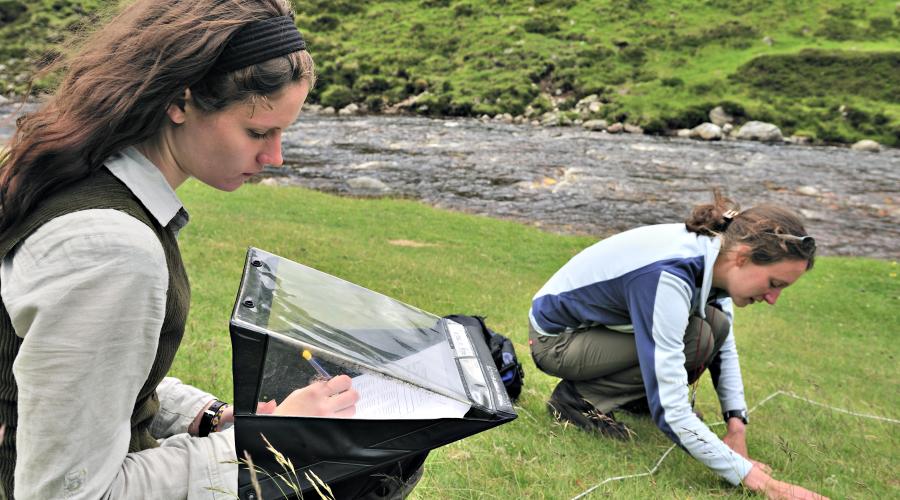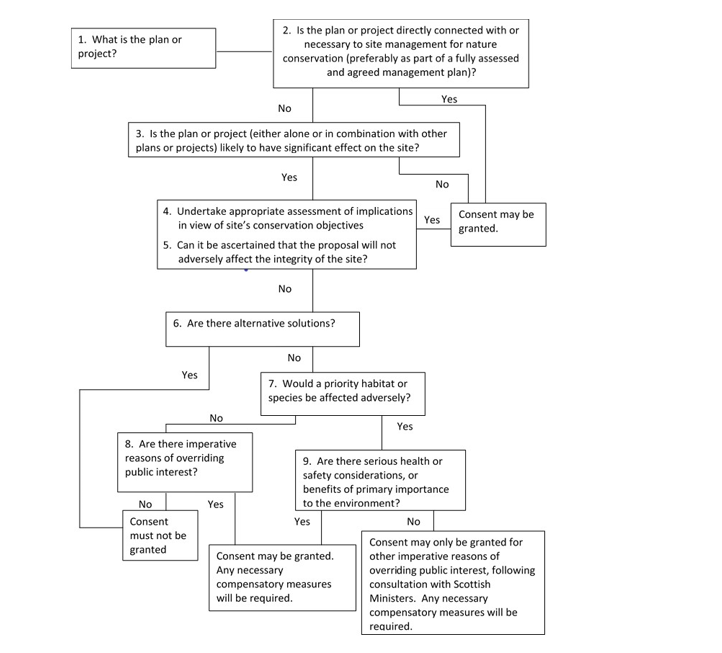
Habitats Regulations Appraisal (HRA)
This precautionary, rigorous and legally binding procedure protects Scotland‘s European sites.
This precautionary, rigorous and legally binding procedure protects Scotland‘s European sites.
Introduction to Habitats Regulations Appraisal (HRA)
Under the Habitats Regulations, all competent authorities must consider whether any plan or project could affect a European site before it can be authorised or carried out. This includes considering whether it will have a ‘likely significant effect’ on a European site, and if so, they must carry out an ‘appropriate assessment’ (AA). This process is known as Habitats Regulations Appraisal (HRA) and is summarised in the following flowchart.
How to consider plans and projects that could affect European sites (SPAs and SACs)

From revised Circular 6/95 with amendments.
Q: Stage 1. What is the plan or project? Move to stage 2.
Q: Stage 2. Is the plan or project directly connected with or necessary to site management for nature conservation (preferably as part of a fully assessed and agreed management plan)?
If "Yes" process complete and consent may be granted. If "No" move to stage 3.
Q: Stage 3. Is the plan or project (either alone or in combination with other plans or projects) likely to have significant effect on the site?
If "No" process complete and consent may be granted. If "Yes" move to stage 4.
Stage 4. Undertake appropriate assessment of implications in view of site’s conservation objectives. Move to stage 5.
Q: Stage 5. Can it be ascertained that the proposal will not adversely affect the integrity of the site?
If "Yes" process complete and consent may be granted. If "No" move to stage 6.
Q: Stage 6. Are there alternative solutions?
If "Yes" consent must not be granted. If "No" move to stage 7.
Q: Stage 7. Would a priority habitat or species be affected adversely?
a. If "No" move to stage 8. Q: Stage 8. Are there imperative reasons of overriding public interest?
i. If "No" consent must not be granted.
ii. If "Yes" consent may be granted. Any necessary compensatory measures will be required.
b. If "Yes" to would a priority habitat or species would be adversely affected move to stage 9.
Q: Stage 9. Are there serious health or safety considerations, or benefits of primary importance to the environment?
i. If "Yes" consent may be granted. Any necessary compensatory measures will be required.
ii. If "No" consent may only be granted for other imperative reasons of overriding public interest, following consultation with Scottish Ministers. Any necessary compensatory measures will be required.
A competent authority must not authorise a plan or project unless it can show beyond reasonable scientific doubt – through an appropriate assessment – that the plan or project will not adversely affect the integrity of a European site.
A competent authority may wish to consent a proposal despite the potential for an adverse effect on site integrity. Where this is the case, it must first show that there are no alternative solutions, and that it is imperative, and of overriding public interest to grant consent. Scottish Ministers must be consulted and any necessary compensatory measures must also be secured.
When does HRA apply?
Any plan or project that could affect a European site – no matter how far away it is – should be subject to HRA.
Competent authorities
A ‘competent authority’ is the authority with the power or duty to determine whether or not a proposal can proceed. The Habitats Regulations state that a competent authority "includes any Minister, government department, public or statutory undertaker, public body of any description, or person holding a public office”.
For example:
- local authorities are competent authorities in regard to planning applications
- Scottish Forestry is a competent authority for felling permissions
- the Scottish Environment Protection Agency (SEPA) is a competent authority for Controlled Activities Regulations (CAR) licences
NatureScot’s role in HRA
The competent authority checks a plan or project for likely significant effects on the European site. While this is a simple test NatureScot can provide help with this if needed.
Where an appropriate assessment is required, the competent authority must consult SNH (NatureScot).
Gathering information
In order to carry out an HRA the competent authority must have sufficient details about all aspects of the proposal and how this will be carried out. Information should also be gathered about the European site(s) that could potentially be impacted, including their qualifying interests and conservation objectives. Information about European sites is available on Sitelink.
The definitive source for qualifying interests is:
– QUIL (Qualifying Interest List) for SACs
– Citation for SPAs (always use the Sitelink version and refer to the covering note where the citations await revision)
Conservation objectives can be found on Sitelink either in the Conservation Advice Package (CAP), Conservation and Management Advice document (CMA) for marine sites, or as a separate conservation objectives document. CAPs and CMAs also list the qualifying interests, their most recent assessed condition (and if unfavourable the reasons for this), and any recommended conservation measures.
How to carry out an HRA
An HRA proforma is available to help guide competent authorities through the process. The stages, as set out in the flowchart above, are summarised below:
Stage 1. What is the plan or project?
- The applicant should provide the competent authority with sufficient information to carry out an HRA.
Stage 2. Is the plan or project directly connected with or necessary to site management for nature conservation?
- This test is to identify and remove from further assessment those proposals which are clearly necessary to, or of value to, or inevitable as part of, management of the site for its qualifying interests. All qualifying interests should be considered.
- Not all proposals for nature conservation management will automatically pass this test.
- For the majority of proposals competent authorities deal with the answer to stage 2 will be ‘no’ and stage 3 should be considered. Further guidance is provided in the HRA proforma.
Stage 3. Is the plan or project (either alone or in combination with other plans or projects) likely to have a significant effect on a European site?
- This is essentially a screening stage to determine whether or not an appropriate assessment is required.
- It should be a relatively quick and straightforward decision but should be fully justified and recorded.
- Each case should be judged on its own merits: what may be significant for one site (or qualifying interest) may not be significant for another.
- Consider whether there is any connectivity between the proposal and each of the qualifying interests i.e. are there processes or pathways by which the proposal may influence the site’s interests directly or indirectly? Consider all possible linkages. For example, is the proposal within the catchment of a freshwater SAC? Or on a flightline associated with an SPA?
- If a proposal is capable of affecting a European site it must be considered, no matter how distant from the site. There is no specified maximum distance from a site boundary beyond which proposals can be dismissed as having no effect.
- If there is no connection, or it is obvious that the proposal will not undermine the conservation objectives despite a connection, conclude no likely significant effect. If you need to ask for a lot of detailed information then it is likely that an appropriate assessment is required. If in doubt about whether there is a likely significant effect, but the potential exists, conclude likely significant effect and move to stage 4, the appropriate assessment.
- The effects of the plan or project should be also be considered ‘in combination’ with the effects of other plans and projects on the same European site to see if there are cumulative or incremental impacts. This should consider both the potential effects of other plans published for consultation and projects seeking consent and any ongoing negative effects of completed plans or projects.
- Any mitigation measures that have been included in a proposal specifically to avoid harmful effects cannot be taken into account at this stage and should be considered within the appropriate assessment.
- Remember HRA differs from Environmental Impact Assessment (EIA) and Strategic Environmental Assessment (SEA). Some of the terms used in all three procedures seem similar in meaning, but their steps, tests and application are very different.
- Further guidance is provided in the HRA proforma.
Stage 4. Undertake an appropriate assessment of the implications for the site in view of its conservation objectives.
- Where a plan or project is considered to have a likely significant effect on the qualifying interest(s) of a European site an appropriate assessment is required.
- The competent authority carries out the appropriate assessment with advice from SNH (NatureScot). The applicant should provide sufficient information to enable the competent authority to carry out the assessment.
- An appropriate assessment is a scientific appraisal of the potential impacts of a plan or project on the qualifying interest(s) of a European site. The appraisal should consider the potential impacts on each qualifying interest and their conservation objectives, including the magnitude and duration of effects and any cumulative effects from other plans or projects. The appraisal should determine whether any of the conservation objectives could be undermined by the proposal. Clear reasons should be provided for any conclusions made.
- Restore objectives may have been set where qualifying features of a site are in an unfavourable condition. In such cases the appropriate assessment should consider whether the plan or project would prevent the qualifying feature from being able to be restored.
- The appraisal need not be difficult or lengthy, the level of detail should reflect the complexity of the case.
- Mitigation to remove or reduce impacts of the proposal can be considered at this stage. However this should not be confused with compensatory measures that can not be considered within an appropriate assessment. Further details on what should be considered when assessing potential mitigation options are outlined in section 4.3 of the European site casework guidance.
- The appraisal should be used to ascertain whether the plan or project will not adversely affect the integrity of a European site (stage 5).
Stage 5. Can it be ascertained that the proposal will not adversely affect the integrity of the site?
- For a plan or project to be consented the appropriate assessment must ascertain that the plan or project will not adversely affect the integrity of a European site.
- It is important to remember that the test is whether the plan or project will not adversely affect the integrity of a European site, not whether it will.
- Conclusions must be made on the basis of there being no reasonable scientific doubt as to the absence of adverse effects. Each case should be judged on its own merits.
- The integrity of the site only applies to the qualifying interests and is directly linked to the conservation objectives for the site. If a plan or project does not undermine the conservation objectives, then the integrity of the site should be maintained or, where relevant, have the ability to be restored. Conversely, if any of the conservation objectives could be undermined, it would not normally be possible to ascertain that the integrity of the site would not be adversely affected.
- If it can be concluded that the proposal will not adversely affect the integrity of a European site, permission may be granted. If not, or there is uncertainty, permission must be refused (subject to the exceptions outlined in stages 6-9 below).
- A competent authority may add legally enforceable conditions to a consent to ensure no adverse effect on the integrity of a European site.
Stages 6 to 9 are only considered in exceptional circumstances where it can not be ascertained that the plan or project will not adversely affect the integrity of a European site.
Stage 6. Are there alternative solutions?
- If it can not be ascertained that the proposal will not adversely affect the integrity of a European site it can only proceed if there are no alternative solutions AND imperative reasons of overriding public interest. This requirement is set out in regulation 49 of the Habitats Regulations.
- Guidance suggests alternative solutions could include alternative locations or routes; different scales or designs of development; alternative processes; or other different, practicable approaches which would have a lesser impact.
- If there are alternative solutions to the proposal consent can not be given. There is then no need to move on to assess whether or not imperative reasons of overriding public interest apply.
- If alternatives are provided it may be necessary to repeat Stages 1-5.
- If there are no alternative solutions stages 7 to 9 should be considered.
Stage 7. Would a priority habitat or species be adversely affected?
- There are no priority species (as defined in the Habitats Directive) in Scotland’s SACs. A full list of priority habitats that are qualifying interests of SACs in Scotland is available on our website. Priority qualifying habitats for individual SACs are identified in the relevant site documentation.
- The Birds Directive does not refer to ‘priority’ species and therefore there are no ‘priority’ bird species in SPAs.
- Priority habitats are given a greater level of protection under regulation 49 of the Habitats Regulations (see below).
Stages 8 and 9. Are there imperative reasons of overriding public interest?
- Where it can not be ascertained that a plan or project will not adversely affect the integrity of a European site, and there are no alternative solutions, a plan or project can only proceed if there are imperative reasons of overriding public interest for doing so (regulation 49 of the Habitats Regulations).
- Scottish Ministers must be consulted.
- Where a priority habitat could be affected imperative reasons of overriding public interest are limited to those reasons outlined in regulation 49. These must relate to human health, public safety, beneficial consequences of primary importance to the environment, or any other imperative reason of overriding public interest subject to the opinion of the Scottish Ministers.
- Where a plan or project is to proceed for imperative reasons of overriding public interest Scottish Ministers have a duty to secure any compensatory measures necessary to ensure the overall coherence of the UK site network is protected (regulation 53 of the Habitats Regulations).
How to record an HRA
An HRA must be:
- reasoned and recorded throughout to provide an audit trail of the competent authority’s thinking
- based on and supported by evidence capable of standing up to scientific scrutiny
There is no standard format for HRA evidence. The exact type of information required varies case by case but the competent authority must ensure the applicant provides sufficient information that definitive conclusions can be made. NatureScot uses an HRA proforma to record appraisals and an example that has been adapted for external use is provided here for information.
A competent authority may not cite lack of information as reason to approve a plan or project.
Help and Advice
General information about European sites
You can use SiteLink to find details of the qualifying interests and conservation objectives for any of Scotland’s European sites (Special Areas of Conservation and Special Protection Areas).
Some sites have Conservation Advice Packages (CAPs) or Conservation and Management Advice Documents (CMAs) that include the conservation objectives for each site as well as other relevant information to benefit the sites. More information can be found in the ‘About conservation advice documents for European sites in Scotland’.
Further information about the habitats and species protected in Scotland’s European sites can be found through the following links:
- Habitats and species of the Habitats Directive which occur in Scotland and for which Special Areas of Conservation are selected
- Priority Habitats in Scotland
Protection and Management
Legislation and policy:
- Read about the Legislative Requirements for European Sites (summary)
- Read about the Scottish Government Policy for proposed SACs and proposed SPAs
- Scottish Government policy on planning in relation to European sites and Ramsar sites is set out in policy 4 of the 4th National Planning Framework (NPF4) (previously paragraphs 207 to 211 of the Scottish Planning Policy 2014). In January 2019 Scottish Government provided guidance on the implementation of their policy on the protection of Ramsar sites.
Guidance:
- Read our European site Casework Guidance and supplementary note on restore objectives.
- Read about the handling of mitigation in Habitats Regulations Appraisal following the People over Wind CJEU judgement.
- Some key concepts are clearly explained in the European Commission guidance Managing Natura 2000 Sites: The provisions of Article 6 and the ‘Habitats’ Directive 92/43/EEC.
- View our advice for planners and developers on protected areas.







